
учебник 3 курс ICT
.pdf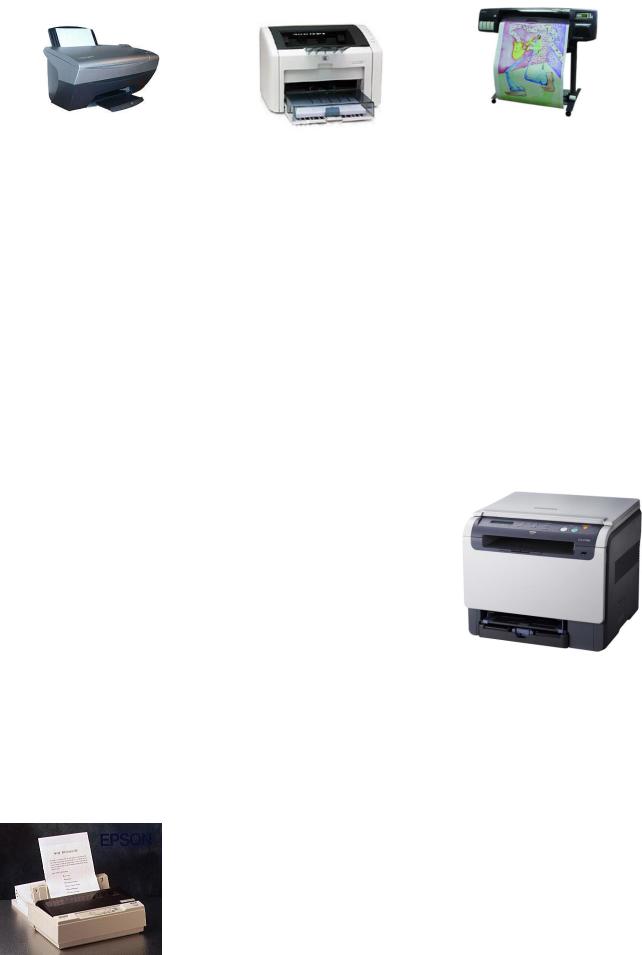
KEY INFORMATION SECTION 3
In computing, a printer is a peripheral which produces a hard copy or printout (permanent human-readable text and/or graphics) of documents stored in electronic form, usually on physical print media such as paper or transparencies. Many printers are primarily used as local peripherals, and are attached by a printer cable or, in most newer printers, a USB cable to a computer which serves as a document source. Some printers, commonly known as network printers, have built-in network interfaces (typically wireless or Ethernet), and can serve as a hardcopy device for any user on the network. In a network, users can share a printer connected to a print server, a computer that stores the files waiting to be printed. Individual printers are often designed to support both local and network connected users at the same time.
In addition, a few modern printers can directly interface to electronic media such as memory sticks or memory cards, or to image capture devices such as digital cameras, scanners; some printers are combined with scanners and/or fax machines in a single unit, and can function as photocopiers.
Printers that include non-printing features are sometimes called
Multifunction Printers (MFP), Multi-Function Devices (MFD), or
All-In-One (AIO) printers. Most MFPs include printing, scanning, and copying among their features.
A Virtual printer is a piece of computer software whose user interface and API resemble that of a printer driver, but which is not connected with a physical computer printer.
A program in your computer, called the printer driver, converts data into a form that your printer can understand. A print spooler stores files to be printed when the printer is ready. It lets you change the order of documents in the queue and cancel specific print jobs.
The output quality, or resolution, is measured in dpi or dots per inch. The speed of your printer is measured in pages per minute (ppm).
A dot-matrix printer uses a group, or matrix, of pins to create precise dots required to shape a character. A print head containing tiny pins strikes an inked ribbon to make letters and graphics. They print text and graphics and nowadays some of them can print up to 500 characters per second (cps). They are slower than laser printers but much cheaper. This
71
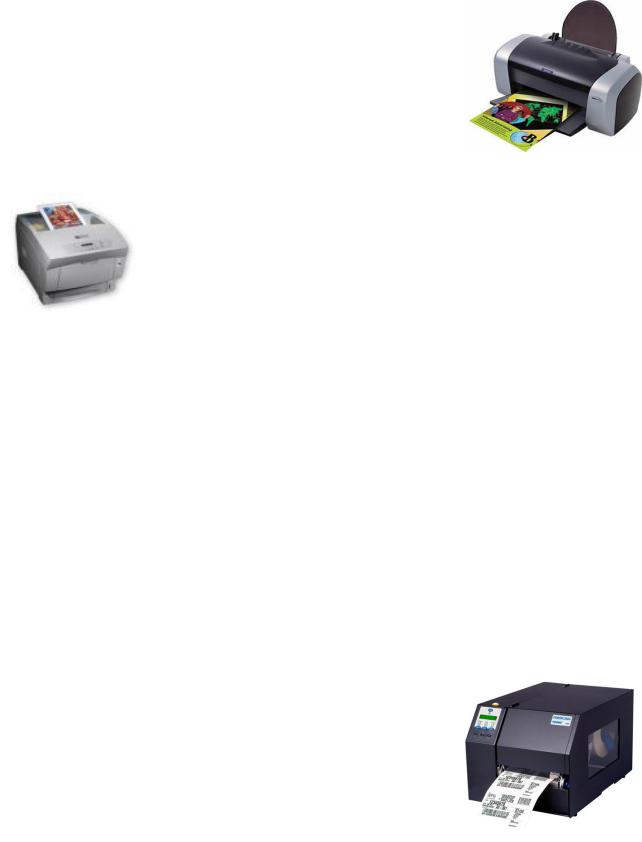
impact printing technology allows shops, for example, to print multi-part forms such as receipts and invoices, so it's useful when self-copying paper is needed. It has two important disadvantages:
noise and a relatively low resolution |
(from 72 to 180 dpi). |
An ink-jet (also called bubble-jet) |
printer generates an image by spraying tiny, precise drops of |
ink onto the paper. This is non-impact printing technology. The resolution ranges from 300 to |
|
1200 dpi, suitable for small quantities or home use. This type of printer is quite fast, silent and not so expensive as a laser printer. A standard ink-jet has a three-colour cartridge, plus a black cartridge. Professional ink-jets have five-colour cartridges, plus black; some can print in wide format, ranging from 60 cm up to 5 metres (e.g. for printing advertising graphics).
A laser printer uses a laser beam to fix the ink to the paper. A laser works like a photocopier – it scans the image with a laser beam and transfers it to paper with a special ink powder called toner which is attracted to paper by an electrostatic charge and then fused on by a hot roller. Laser printers are fast and produce a high resolution of 1,200 to 2,400 dpi, so they are ideal for businesses and for professional graphics work. They are constantly being
improved. Lasers use a page description language or PDL which describes how to print the text and draw the images on the page. The best-known languages are Adobe PostScript and HP Printer Control Language.
A professional imagesetter is a typesetting printer that generates very high-resolution output (over 3540 dpi) on paper or microfilm. It's used for high-quality publications in desktop publishing. In addition, it is extremely fast. Although it produces the highest quality output, it has one important drawback: it is too expensive for homes or small offices.
Thermal transfer printers use solid sticks of colored ink (similar in consistency to candle wax), which are melted and fed into a piezo crystal operated print-head which sprays the ink on a rotating, oil coated drum. The paper then passes over the print drum and the image is transferred, or transfixed, to the page. Drawbacks of the technology include high power consumption and long warm-up times from a cold state.
Thermal printers work by selectively heating regions of special heat-sensitive paper. They are silent and considered to be inexpensive. Monochrome thermal printers are used in cash registers, ATMs, gasoline dispensers and some older inexpensive fax machines. Colors can be achieved with special papers and different temperatures and heating rates.
72
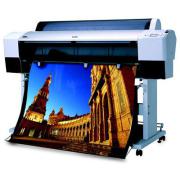
A plotter is a vector graphics (using geometrical primitives such as
points, lines, curves, and shapes |
or polygon(s), which are all based |
on mathematical equations, to |
represent images in computer |
graphics) printing device which uses ink and fine pens held in a carriage to draw detailed designs on paper. It's used in computeraided design, maps, 3-D technical illustrations, construction plans, engineering drawings and other technical illustrations.
VOCABULARY PRACTICE SECTION 3
1. |
Complete the gaps choosing the right option. |
|
||
1. |
Input-output |
devices allow the computer to ………. with its external environment. |
||
a) compute; b) command; c) communicate. |
|
|||
2. |
An I/O interface is a special ………. that converts input data to the internal codes. |
|||
a) register; b) processor; c) plotter. |
|
|||
3. I / О ……… match the physical and electrical characteristics |
of input-output devices. |
|||
a) interchanges; |
b) interfaces; c) interpretations. |
|
||
4. |
Letter-quality, dot-matrix and ink-jet printers are all ……… printers. |
|||
a) line; b) page; c) character. |
|
|
||
5. |
Input-output |
units link the computer to its external ……… |
|
|
a) requirement; |
b) development; |
c) environment. |
|
|
6. I / О devices can be classified |
according to their speed, visual |
displays being ……… devices. |
||
a) high-speed; b)medium-speed; |
c) low-speed. |
|
||
2. Look at these extracts from people talking about printing jobs. Which type of printer is each person talking about?
1. |
―Can you order some more toner for the printer on the third floor?‖ |
2. |
―The plans for the new office building are almost ready. Shall I print a copy for the meeting ?‖ |
3. |
―We‘re almost out of bar codes. Simon, can you print some more?‖ |
4. |
―I couldn‘t believe it – I was in the middle of printing my report and I ran out of ink!‖ |
5.―As soon as the client approves this version, you need to print a high-quality colour copy for them to check.‖
6.―Andrew, can you print off another set of address labels for me?‖
73
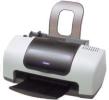
3. |
Complete these sentences with words from the Key Information Section. |
|
1. |
The differences in ……. are noticeable: the more dots per inch, the clearer the image. |
|
2. |
A resolution |
of between 600 and 2400 ……. ensured that even text as small as 2 pt was legible. |
3. |
Passengers |
with an electronic ticket will need a …….. of ticket confirmation or a boarding pass |
to be admitted |
to secured gate areas. |
|
4.The key advance of recent years is printing speed: the latest generation of ink-jets prints black- and-white text at 15 …….(…..).
5.With appropriate software, you can view the images on a computer, manipulate them, or send them to a ……. and produce excellent quality colour copies.
6.A ……. is a dedicated computer that connects a printer to a network. It enables users to share printing resources.
7. |
A ……. is a utility that organizes and arranges any documents waiting to be printed. |
||||
8. |
In computers, a ……. is a program installed |
to control a particular |
type of printer. |
||
4. |
Choose the most appropriate type of printer for these situations. |
|
|||
1. |
a home user who wants to print text documents and family photographs. |
||||
2. |
businessmen who need to print in large quantities at high quality |
in an office. |
|||
3. |
engineers who want to make detailed line |
drawings. |
|
||
4. |
professional typesetters in desktop publishing (e.g. to publish magazines). |
||||
5. |
a company that wants to print carbon copies of bills and receipts. |
|
|||
5. |
Identify these types of printers. |
|
|
||
|
1. |
The resolution depends on the number |
of pins (9, 24 or 48) |
|
|
|
2. |
The quality (resolution) of the images |
ranges from 300 to 1,200 dots per inch (dpi) |
||
|
3. |
Provides high quality |
output - a resolution of 600/2,400 (dpi) |
|
|
|
4. |
Provides the highest |
resolution - more than 3,000 dpi |
|
|
|
5. |
Provides high quality |
for linework (like lines and curves) |
|
|
6. Find the terms which correspond to these definitions.
1. a container that holds the ink in an ink-jet printer.
2.powdered ink used in laser printers.
3.small needles that press on the inked ribbon to make the characters on paper.
74
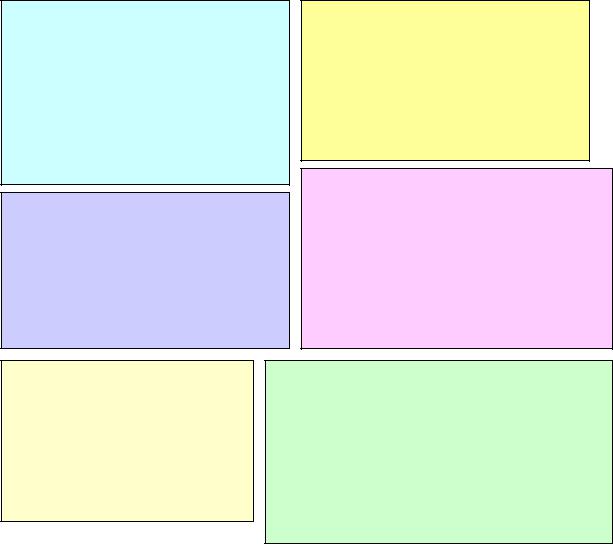
4. |
technology |
that produces text and pictures |
by hammering pins against a ribbon and the paper. |
5. |
a language |
that tells a printer how to print |
a document. |
6. |
a peripheral |
combining a printer, a fax machine, a photocopier and a scanner into one device. |
|
7. Read the advertisements for printers below, and then answer the questions. Look at the advertisements again and compare the printers. Talk about their: speed, memory, fonts, emulations, resolution, service, price, noise.
CRYSTAL LASER PRINTER II
14 pages per minute. 20 MB RAM. Two
200 sheet selectable input trays. LCD display. 80 internal scalable fonts. A resolution of 2,400 dpi. Comes with PostScript language and PCL (printer control language). Telephone hotline support. ₤999
COLOUR INK-JET
Stunning Plug & Play colour printer. Brilliant photo quality (up to 720 dpi) and fast-drying ink. Produces 8 pages per minute in plain text and 4 ppm in colour. 150 page paper tray. Fast, friendly service. ₤210
MICRO LASER XT
Personallaser printer. 5 pages per minute. 4 MB RAM expandable to 64 MB. Parallel interface. 200 sheet input tray. 35 resident fonts. One-year on-site maintenance. Prints
on a wide range of materials and sizes. ₤649
COLOUR POSTSCRIPT PRINTER
Colour printer. 40 Adobe Postscript fonts. 36 MB RAM with a SCSI Interface for an optional 20 MB hard disk. Parallel, serial and AppleTalk interfaces. HP plotter emulation. Thermal printing system. 30-day money-back guarantee and 1 year's on-site parts and labour. ₤2249
STYLUS DOT-MATRIX PRINTER Dot-matrix printer with 24 pins. Prints text and graphics. 450 cps. Compatible special interface. Free unlimited hotline support for our customers. One year on-site maintenance. ₤179
TURBO LASER WRITER QR
Workgroup laser printer. 15 pages per minute. 1,200 dpi for graphics. 36 MB of RAM. Includes Adobe Postscript and Hewlett Packard PCL printer languages. 75 resident fonts. Connectivity: one bi-directional parallel port, one LocalTalk port, and one Ethernet port for networks. 12 month warranty. ₤1150
1. |
How many laser printers are advertised here? |
|
2. |
Is there a printer that operates by spraying ink droplets onto paper? |
|
3. |
Which |
laser printer offers the highest resolution, or output quality? |
4. |
Which |
one would you recommend to a friend who does not have much money? |
5.Which one has more internal fonts?
6.Can you find two types of laser printer languages?
7.What connectivity features are offered by the Turbo laser Writer QR?
75

GRAMMAR PRACTICE SECTION
Reported speech.
1. Match the sentences with the explanations.
1. |
no tense change – past simple, |
a. |
The employer asked what computer applications the |
|
|
past perfect |
|
candidate used. |
|
2. |
no tense change - information |
b. |
He said the hacker who illegally accessed our databases |
|
|
is still true |
|
was arrested the day before. |
|
3. |
no tense change – always true |
c. |
He asked the technician |
to debug the program. |
4. |
no change - modal verb |
d. |
They told the manager |
to update the database. |
5. |
change of reference to people, |
e. |
The CEO said that our stock control had been |
|
|
places, time, things |
|
computerized completely. |
|
6. |
tense change – move back in |
f. |
It was confirmed that the new computer equipment was |
|
|
time |
|
improving the performance of all the departments. |
|
7. |
reported question |
g. |
He said computers are getting smaller and smaller. |
|
8. |
reported request |
h. |
He said there is always |
a bug in any program. |
9. |
reported command |
i. |
The technician said the company should install new |
|
|
|
|
antivirus software. |
|
10. passive reporting verb |
j. |
She pointed out that people used prototypes of computers |
||
|
|
|
in ancient times. |
|
2. Report the following sentences trying to use various reporting verbs.
1. |
Shadow data contains the remnants of computer data that was written previously to a track. |
2. |
In recent years flat screens have become increasingly popular. |
3.Prices for flat screens are falling.
4.The world's first computer printer was a mechanically driven apparatus invented by Charles Babbage.
5.Would you mind printing this out for me?
6. |
Many computer |
systems allow the user to install or create any user interface they desire. |
|
7. |
Carelessly-arranged computer screens and keyboard could lead to ergonomics |
problems |
|
|
such as eyestrain |
and repetitive strain injuries while using a keyboard for long |
periods. |
8.A hacker broke into our security system last week.
9.I found the problem when I was launching this program.
76
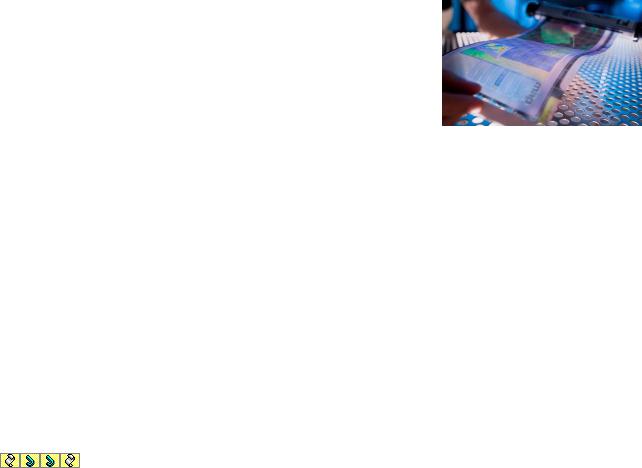
10.As technology improved during the 1990s, the usefulness and popularity of laptops increased.
11.What basic functions does a computer perform?
12.The 2000s saw the rise of multi-core processors and flash memory.
13.Do not interrupt the spelling checker while it is running.
14.You've saved this file in the wrong directory.
15.If you buy a modem make sure it conforms to Hayes™ standards.
16.He reconfigured the field structure in the file.
READING PRACTICE SECTION
Bend me, shape me, anyway you want me
Electronic screens as thin as paper are coming soon
Over the years, the screens on laptops, televisions, mobile phones and so on have got sharper, wider and thinner. They are about to get thinner still, but with a new twist. By using flexible components, these screens will also become bendy. Some could even be rolled up and slipped into your pocket like a piece of electronic paper. These thin sheets of plastic will be able to display words and images; a book, perhaps, or a newspaper or a magazine. And now it looks as if they might be mass produced in much the same way as the printed paper they are emulating.
The crucial technological development happened recently at the Flexible Display Centre at Arizona State University. Using a novel lithographic process invented by HP Labs and an electronic ink
produced by E Ink, the centre‘s researchers succeeded in printing flexible displays onto long rolls of a special plastic film made by DuPont. To make individual screens, the printed film is sliced up into sections rather as folios for magazines or newspapers would be cut from a printed web of paper.
The resulting ―electrophoretic‖ screens are |
lightweight and consume only a fraction of |
||
the power of a typical LCD . The first |
trials of consumer |
versions |
could begin within a few years. |
Flickering beginnings |
|
|
|
Although printing flexible screens in |
this way will help |
to make |
them affordable, they still have a |
long way to go to catch LCDs. For that, two things need to happen. One is that the displays must turn from black-and-white to colour. The other is that they must be able to refresh their images at a rate fast enough to show moving pictures. Researchers at the Flexible Display Centre and elsewhere are working on ways to do that, and there seems little doubt it will happen. Yet even with their present limitations, flexible screens have some important advantages over LCDs.
77
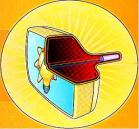
For a start, LCDs are difficult and costly to make. Most are produced in huge, ultra-clean factories using batch processes similar to those for making silicon chips. This is a fractious, finicky process and tiny defects in the materials, or failures in the alignment of the different layers, can result in 20% or more of a batch being scrapped. Moreover, the glass means LCDs are heavy and easily broken, as anyone who has dropped a laptop knows to his cost.
Another drawback is that LCDs consume a lot of power because they are lit from behind. It also means that the image can be hard to see in bright sunlight.
Electrophoretic displays work in a different way, using a form of electronic ink that has been under development since the 1970s. E Ink‘s version employs tiny capsules filled with a clear fluid containing positively charged white particles and negatively charged black ones. The capsules are arranged as pixels and electric charges applied to each pixel pull either the black or the white particles towards the top of the capsule (and the opposite colour to the bottom). Unlike an LCD‘s, this image does not require backlighting. Instead, the user relies on reflected light, as he would if he were reading a sheet of printed paper. Moreover, once the particles in the capsules have settled down they stay put. That means the image remains on the screen without drawing power. A further dose of electricity is required only when the image changes; when a user ―turns‖ to the next page, for example. Not only does this mean that electrophoretic displays are cheaper to run, the lack of constant refreshment makes them more comfortable to read—as comfortable, it is claimed, as printed paper.
Colour section
The one feature these screens do not yet offer is colour and, though colour versions will surely come to market, no one is yet sure which version will succeed. Electrophoretic displays can use coloured particles and filters to produce red, green and blue subpixels, but as each colour occupies only a
third of a pixel‘s area, the brightness of the image is correspondingly reduced. Liquavista, a spin-off from Philips, is trying something called ―electrowetting‖. This uses an electrical field to modify the surface tension of coloured oils and water within pixels that are mounted on a flexible Teflon base.
As each pixel is activated, |
the wetting |
properties of the oil and water |
change, |
making |
colours |
|
visible. |
|
|
|
|
|
|
Another approach is to use materials that emit light. Some firms, such as Sony, are looking |
at |
|||||
organic light-emitting diodes |
composed |
of thin films of organic molecules |
which |
generate |
light |
in |
response to an electric current.
Photonic crystals are a further alternative. These are tiny particles that have a crystal structure which influences the flow of photons, the particles of light. By changing the structure of such a crystal slightly, using an electric charge, the colour of the light reflected by that crystal will change too. Tune the crystals appropriately and you can create different colours.
78
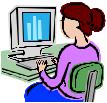
There are also hybrid methods, like that used by Adrian Geisow at HP Labs‘ campus in Bristol,
England. He has taken a conventional approach to generating colour, using liquid crystals and red, green and blue filters. However, he has done so in a plastic film produced in a printing-type process. The screen can be backlit, like a standard LCD, but it is capable of retaining its image because the material the liquid crystals sit on encourages the pixels to stay transparent or opaque once they have been switched. However it is eventually done, Dr Geisow is convinced that putting colour into flexible screens is what will turn them into a very big picture indeed.
Read the comments to the article. Which comments do you agree with? Why? Which one(s) do you like best? What is your opinion on the article and on the technology it talks about? Do you think there is a future for it? What would you write to comment it?
Readers comments
1. Very inspiring! Can we do away with the tons and tons of newsprint tossed in the garbage bin every day? That would save the world many trees every day, and maybe
even my mail slot a few useless flyers I never read. 2. I have been hearing about these flexible organic display being 'just around the
corner' for at least a decade - haven't seen one yet at my local Best Buy.
3.I can see myself using this flexible display to wallpaper my home. Then in the blink of an eye, I could change the theme of my home to whatever I desired. Now all I need is some holographic furniture to go with it.
4.If it‘s comfortable to use for lying about and waterproof for the tub it will be as good as the Economist magazine to me. If I can comment on the articles using the internet version it will be better.
5.Great, soon people will read the newspaper on these walking down sidewalks and down hallways. Everyone will bump into each other and the world will be a friendlier place. I guess these
devices could save paper/trees but, once obsolete, they will just pile up as e-waste when they return to their birthplace in China.
SPEAKING/WRITING PRACTICE SECTION
1. Decode the abbreviations related to computer output. Find more similar abbreviations.
CRT LCD TV PC TFT USB VGA VDU PDL dpi cpm ppm cps
2. Describe the monitor of your computer and its performance characteristics. How can you change the picture using the controls?
79
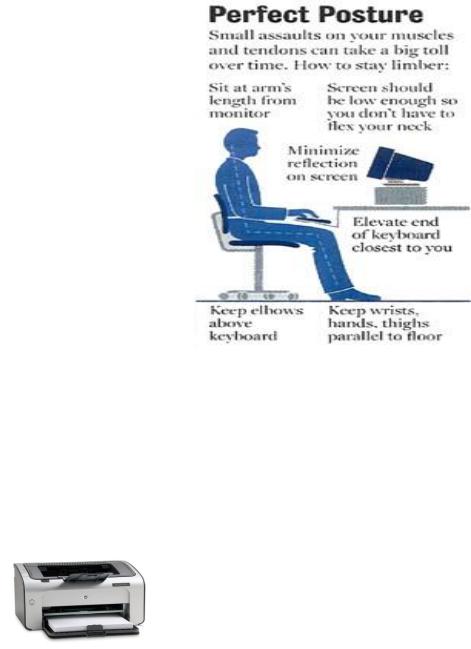
3. Read about what you should do to protect your eyes when working on a computer. Add more recommendations to this list. Do you always follow these recommendations?
4. Describe the 'home cinema' of your dreams. Use these notes to help you.
|
Type of display: CRT television, LCD screen, plasma TV or video projector |
|||
|
Screen size |
|
Resolution (image |
quality) |
|
Video source: TV, VCR or DVD recorder |
|
Sound capabilities |
|
5. Describe the characteristics of the printer that you have or would like to have at home or at work. Give details about: type of printer, speed, noise, resolution, ink cartridges, price and customer support.
5.Make a report on one of the topics below.
The evolution of output technologies.
Functions and technical characteristics of different output devices (especially those not
|
described in detail in the Key Information Sections). |
|
New multi-functional generation of input-output devices. |
|
The future of output devices and technologies. |
80
